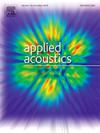Phase relationships of finite amplitude ultrasound waves and its application in determining nonlinear acoustical parameters
IF 3.4
2区 物理与天体物理
Q1 ACOUSTICS
引用次数: 0
Abstract
Compared with second harmonics, phase relation contains more comprehensive nonlinear characteristics, and is proposed to determine the nonlinear acoustical parameter. Based on perturbation theory, the previous 16 harmonic solutions are solved automatically. Hilbert transform is employed to evaluate the phase of nonlinear signal, and phase shift is obtained by subtracting the phase of a nonlinear signal from that of a reference linear signal. Meanwhile, thermodynamic method is also analyzed and which make it easier to calculate phase shift. Then, nonlinear ultrasound experiments are performed in distilled water to verify the theoretical results. It shows that the simulated phase and phase shift are consistent with experiments. With experimental phase shift data collected at different propagation distances and of different excitation levels, the nonlinear parameter of water is calculated ( = 3.44 at 18℃) with an optimization method. It shows that determining nonlinear parameter with phase shift not only avoids the use of inaccurate second harmonic perturbation solution, but also eliminates the need for extracting fundamental and harmonic amplitudes. This work enriches the propagation theory of finite amplitude waves and provides a new method for nonlinear ultrasonic detection and evaluation.
求助全文
约1分钟内获得全文
求助全文
来源期刊

Applied Acoustics
物理-声学
CiteScore
7.40
自引率
11.80%
发文量
618
审稿时长
7.5 months
期刊介绍:
Since its launch in 1968, Applied Acoustics has been publishing high quality research papers providing state-of-the-art coverage of research findings for engineers and scientists involved in applications of acoustics in the widest sense.
Applied Acoustics looks not only at recent developments in the understanding of acoustics but also at ways of exploiting that understanding. The Journal aims to encourage the exchange of practical experience through publication and in so doing creates a fund of technological information that can be used for solving related problems. The presentation of information in graphical or tabular form is especially encouraged. If a report of a mathematical development is a necessary part of a paper it is important to ensure that it is there only as an integral part of a practical solution to a problem and is supported by data. Applied Acoustics encourages the exchange of practical experience in the following ways: • Complete Papers • Short Technical Notes • Review Articles; and thereby provides a wealth of technological information that can be used to solve related problems.
Manuscripts that address all fields of applications of acoustics ranging from medicine and NDT to the environment and buildings are welcome.
 求助内容:
求助内容: 应助结果提醒方式:
应助结果提醒方式:


